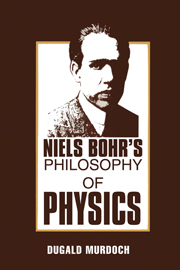Book contents
- Frontmatter
- Contents
- Dedication
- Preface
- Acknowledgements
- 1 Wave-particle duality
- 2 Niels Bohr and wave-particle duality
- 3 From duality to complementarity
- 4 The meaning of complementarity
- 5 The foundations of kinematic-dynamic complementarity
- 6 Bohr's theory of measurement
- 7 Bohr's theory of properties
- 8 Einstein versus Bohr
- 9 The sequel to the Bohr-Einstein debate
- 10 Bohr's philosophy of physics
- 11 An appraisal of Bohr's philosophy of physics
- Notes
- Index
2 - Niels Bohr and wave-particle duality
Published online by Cambridge University Press: 01 June 2011
- Frontmatter
- Contents
- Dedication
- Preface
- Acknowledgements
- 1 Wave-particle duality
- 2 Niels Bohr and wave-particle duality
- 3 From duality to complementarity
- 4 The meaning of complementarity
- 5 The foundations of kinematic-dynamic complementarity
- 6 Bohr's theory of measurement
- 7 Bohr's theory of properties
- 8 Einstein versus Bohr
- 9 The sequel to the Bohr-Einstein debate
- 10 Bohr's philosophy of physics
- 11 An appraisal of Bohr's philosophy of physics
- Notes
- Index
Summary
What was Bohr's response to the problem of wave-particle duality? Before considering this question in detail it will be useful to survey briefly Bohr's work in physics between 1911 and 1923.
Bohr and the ‘old’ quantum theory
In 1911 Bohr completed his doctoral dissertation on the classical electron theory of metals. Developed by Sir J.J. Thomson and Lorentz, the theory explained electrical, magnetic and thermal properties of metals in terms of the motions of free electrons. Although Bohr made no use of the quantum hypothesis in his dissertation, he noted that classical electrodynamics was incapable of explaining Planck's radiation law and entailed the ultraviolet catastrophe.
After completing his dissertation Bohr pursued his post-graduate studies under Thomson at Cambridge University. Finding that Thomson was little interested in his work, Bohr went on to Manchester University in March 1912, to work under Ernest Rutherford. Bohr's move to Manchester was very opportune: the quantum hypothesis was just beginning to receive a wider recognition, thanks largely to the first Solvay Conference in 1911, which Rutherford attended; Rutherford's laboratory, moreover, was one of the most active centres in the investigation of radio-activity.
In order to explain the results of experiments on the passage of alpha and beta particles through matter Rutherford had revived Hantaro Nagaoka's (1904) planetary model of the atom. On this model an atom consists of a positively charged nucleus which is orbited by negatively charged electrons, the number of which corresponds to the number of charges on the nucleus.
- Type
- Chapter
- Information
- Niels Bohr's Philosophy of Physics , pp. 16 - 33Publisher: Cambridge University PressPrint publication year: 1987



